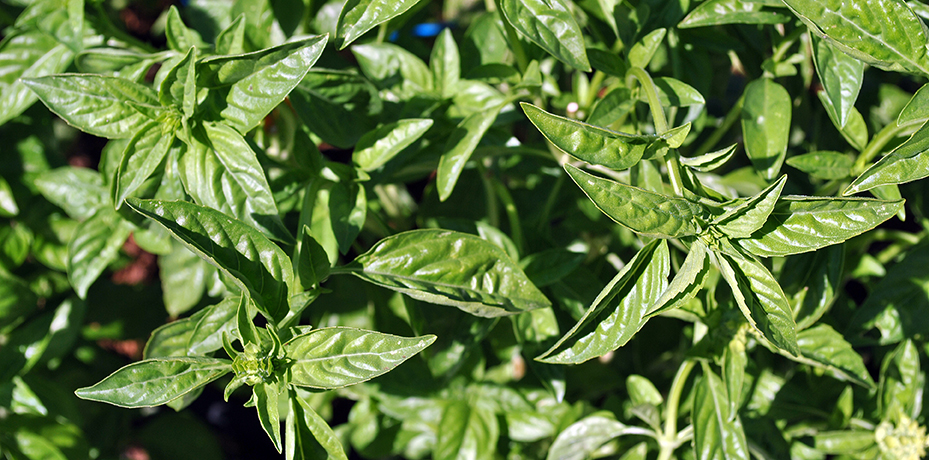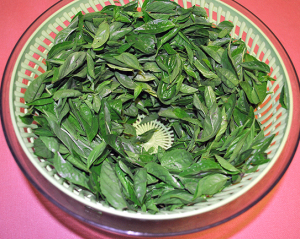An Abundance of Basil

75 Plants Yield a Year’s Worth of Pesto and More!
Early September is still harvest season in Seattle. That means I’m spending more time in the kitchen processing our bounty, and less time at the computer working on this blog. To top it off, June was drier than normal this year, followed by hotter than normal temperatures in July through mid-August. The result was a bumper crop of tomatoes and basil at least a month early! Luckily I have some easy recipes and a big freezer in my basement. Basil is my favorite herb because of its versatility, distinct flavor and heavenly aroma.
 We plant a full bed of basil—nearly 75 plants—probably far more than we need. I give a lot away, and use it all summer long for a variety of recipes like pesto, Caprese salad, spaghetti sauce, and soups. It adds a nice zip to green smoothies too!
We plant a full bed of basil—nearly 75 plants—probably far more than we need. I give a lot away, and use it all summer long for a variety of recipes like pesto, Caprese salad, spaghetti sauce, and soups. It adds a nice zip to green smoothies too!
Planting Basil
It’s best to use seed formulated for your region whenever possible, we start our basil using Territorial Seeds’ Aroma. That variety does well in Seattle, and the flavor is strong; their scent lives up to it’s name. The starts go out by mid-May with no outside protection. Seattle has cool spring nights, so any earlier would require row-covers. This year, we had some basil ready for harvesting by mid-July.
Harvesting Basil
 Because Seattle has such a mild fall climate, it’s possible to keep basil growing until the first frost, so harvesting is an on-going process. I select the center/main stems first, leaving the plant to send off new shoots. I gather the stems in a large market basket, then my hubby and I spend an hour or so plucking leaves from stems. This is best done outdoors as it can get messy.
Because Seattle has such a mild fall climate, it’s possible to keep basil growing until the first frost, so harvesting is an on-going process. I select the center/main stems first, leaving the plant to send off new shoots. I gather the stems in a large market basket, then my hubby and I spend an hour or so plucking leaves from stems. This is best done outdoors as it can get messy.
The leaves are then washed and dried using a salad spinner. It’s the best approach since basil leaves bruise easily. The stems go into our compost pile to help enrich next season’s soil.
Processing/Preserving Basil
The majority of my basil gets turned into Pesto Genovese using the version in More Recipes from Moosewood Restaurant (available as a Kindle edition, or used). I make double-batches in my Cuisinart and portion it out into ½-pint containers for the freezer. It tastes fresh when thawed and the size is just right for two–three servings of pasta. It makes a great dip or spread too! I freeze a few pints and quarts so I can serve more people.
 My roasted tomato sauce recipe calls for a mixture of basil, oil and garlic. I make this in portioned batches and freeze it for future use as the tomatoes ripen. I also freeze some in small quantities for use in soups and other recipes throughout the fall/winter. Many people use ice-cube trays for this, but I find they get too greasy. Instead, I save salsa containers from take-out meals and use those. They hold about two tablespoons and stack easily in the freezer. I’ve also put tablespoon-sized dollops of basil/oil/garlic mixture on a cookie sheet covered with parchment and put in the freezer for an hour or two. Once frozen, they can be taken of the sheet and stored in a container or zip-lock in the freezer.
My roasted tomato sauce recipe calls for a mixture of basil, oil and garlic. I make this in portioned batches and freeze it for future use as the tomatoes ripen. I also freeze some in small quantities for use in soups and other recipes throughout the fall/winter. Many people use ice-cube trays for this, but I find they get too greasy. Instead, I save salsa containers from take-out meals and use those. They hold about two tablespoons and stack easily in the freezer. I’ve also put tablespoon-sized dollops of basil/oil/garlic mixture on a cookie sheet covered with parchment and put in the freezer for an hour or two. Once frozen, they can be taken of the sheet and stored in a container or zip-lock in the freezer.
Finally, I pop anywhere from 1/4–1/2-cup of cleaned basil leaves into a snack-sized zip-lock baggie—making sure to squeeze out the excess air—and freeze these for cooking as well. I’ve been experimenting with other uses—stay tuned for my adventures infusing vodka with basil!
The whole process is admittedly, a lot of work, but the outcome is a variety of homegrown, organic basil for use year-round.
- Words by Andrea Leigh Ptak
- September 16, 2014
- 4 Comments

Looks like a bumper crop! I just can’t get enough basil. My potted basil didn’t do so well this year. Thanks for the tips.
Thanks for all the tips. Basil is absolutely my favorite herb too. I lived in Naples when I was 3, and when fresh basil was just catching on here years ago the smell of it used to drive me wild. I realized it was one of my first sensual impressions!
Andie, won’t the basil leaves turn brown when you freeze them in the baggies?
The color changes some, but the flavor holds fine for a soup or sauce. I also dry basil for future use as well.